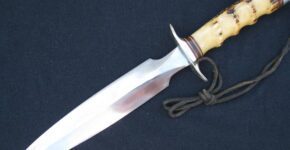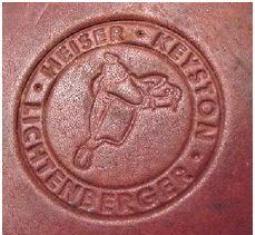


I have been sitting on this for quite some time and finally decided to go with it. It has been eight years since my last article in the RKS newsletter on Johnson sheaths, and in the ensuing years, some retrospective thought as well as new information has come to light. Hopefully this will bring us a bit closer to an answer.
A few years ago I had the pleasure of a conversation with Mr. Hugh Wright of St. Cloud, Florida. Mr. Wright was a Randall Made Knives employee from the late 1950’s through the early to mid 1960’s. Mr. Wright gave me a brief history of his employment and what he remembers of the shop in those days.
My particular focus of questioning was about the sheaths of the time period, and who was making them. Mr. Wright stated that Heiser was the main sheath maker when he started working at Randall Made Knives. He also stated there was another fellow that began making a few sheaths and some one off stuff shortly thereafter. This maker was Maurice Johnson.
Maurice Johnson, a retired police officer, worked supplying harness leather for the Ben Wright Raceway in Orlando, Florida, in the late 50’s and early 60’s. Hugh Wright emphatically stated with no hesitation that he saw Maurice in the Randall shop at least as early as mid-1961, and that Maurice was supplying sheaths to the shop at that time. When asked how he could be sure Mr. Wright stated “I was the employee sheathing the knives at that time, and I know what was being used!” This is where it gets sketchy, as Gary Randall has on record said he “found” Maurice Johnson in Maitland, Florida, by accident in 1962 when driving through the town not too far from his home. I believe Gary is accurate in his account and Mr. Wright is off by a few months or more.
Mr. Wright stated that Maurice had been supplying specialty sheaths for some time prior to him going into full production and also stated it didn’t take Mr. Johnson but 5-6 months to come up to full production. According to Mr. Wright, Heiser sheaths were still in the shop but Johnson was fast becoming the go to guy with the last shipment from Heiser arriving in 1962.
I asked Mr. Wright about the possiblility of stamping sheaths in the Randall Shop and he said that never happened that he recalls. He also said he did not know if Bo had sent a RMK stamp to Heiser. I stated in the 2004 article there is no written record we know of and no verbal mention of this ever happening, and this has not changed in the interim. In conversation with former Randall shop foreman Pete Hamilton and asking about the possibility of stamping sheaths in the Randall shop, he said since he started working there in 1965, he did not recall ever seeing a sheath stamped there either.
Following is quoted a brief history of the H.H. Heiser Saddlery Company from the website www.vintagegunleather.com
“In 1945, after 87 years as a family owned and operated business, The Hermann H. Heiser Saddlery Company was bought by The Denver Dry Goods Company, one of the retailers the Saddlery had supplied for many years. The Denver Dry Goods Company continued to market and sell under the H. H. Heiser Saddlery Company name and continued to use the maker marks and logos as though nothing had changed in the company. This continued until 1950 when The Denver Dry Goods Company sold The Hermann H. Heiser Saddlery Company to Keyston Brothers Saddlery of San Francisco, CA with the Keyston Brothers marketing under the Heiser – Keyston combined names. The Keyston Brothers Company developed a line of holsters called the Heiser – Keyston Sportsman Line of economical holsters that were made to fit a range of guns, they were not made to order as previously for a specific gun. In 1958 Keyston Brothers bought out the Lichtenberger – Ferguson Saddlery in Los Angeles, and the designated name on the Maker Mark was Heiser – Keyston – Lichtenberger. This logo was used until the Keyston Brothers left the Saddlery Business and they went into Automotive Upholstery.”
There is an undeniable resemblance of these early “Johnson” sheaths to Heiser sheaths. So close in fact, that without turning them over to see the stamp, the vast majority would be hard pressed to see any difference, primarily because there really isn’t any. My view on this topic has changed to some degree over the years, and I am now not so convinced that these sheaths weren’t in fact made by the last incarnation of what had historically been known as the H.H. Heiser Saddlery Company.
My final thought is that for my collecting purposes, and the resemblance to Heiser sheaths aside, until some evidence arises to determine otherwise I still consider all these early sheaths with the Randall Made Knives logo to be made by Maurice Johnson. It just keeps it nice and simple because many folks get confused otherwise.
**Note Early 2015: When the last paragraph was written, my intent was to keep it simple (as stated) for most collectors. Now, as time has passed and more studying has further confirmed my thoughts outlined in the article above, thoughts myself and a couple other collectors had been discussing for some time, that the sheaths in question are in fact HKL (Heiser) sheaths. The major hang-up was the premise that HKL (Heiser) never had an RMK leather logo stamp. This certainly was incorrect as it is the only explanation. Collectors need to take note of this when examining knives, and know these are not Johnson sheaths. I will in time write Part IV to this series.